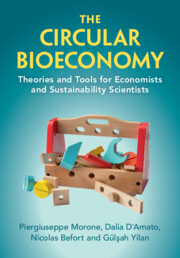Book contents
- The Circular Bioeconomy
- The Circular Bioeconomy
- Copyright page
- Contents
- Figures
- Tables
- Preface
- Acknowledgements
- Note on the Text
- Abbreviations and Notations
- Part I
- Part II
- Part III
- 7 LCA, LCC, and S-LCA Applied to the Bioeconomy
- 8 Innovation Systems and Global Value Chains in the Bioeconomy
- 9 Monitoring Progress towards a Sustainable and Just Bioeconomy
- Index
- References
7 - LCA, LCC, and S-LCA Applied to the Bioeconomy
from Part III
Published online by Cambridge University Press: 26 October 2023
- The Circular Bioeconomy
- The Circular Bioeconomy
- Copyright page
- Contents
- Figures
- Tables
- Preface
- Acknowledgements
- Note on the Text
- Abbreviations and Notations
- Part I
- Part II
- Part III
- 7 LCA, LCC, and S-LCA Applied to the Bioeconomy
- 8 Innovation Systems and Global Value Chains in the Bioeconomy
- 9 Monitoring Progress towards a Sustainable and Just Bioeconomy
- Index
- References
Summary
This chapter presents tools that focus on products and processes. Specifically, the chapter moves from the assumption that a bioeconomy is unsustainable by definition. Its sustainability (and superiority with respect to the fossil-based economy) has to be proved in a rigorous way, making use of improved methodologies and scientifically sound assessment tools. To this end, this chapter provides an overview of a harmonised approach for an environmental (LCA), social (SLCA), and economic (LCC) assessment of the sustainability of bio-based products and processes – taking into due consideration elements like end-of-life options as well as indirect land use change associated with the market penetration of bio-based products.
Keywords
- Type
- Chapter
- Information
- The Circular BioeconomyTheories and Tools for Economists and Sustainability Scientists, pp. 125 - 149Publisher: Cambridge University PressPrint publication year: 2023



